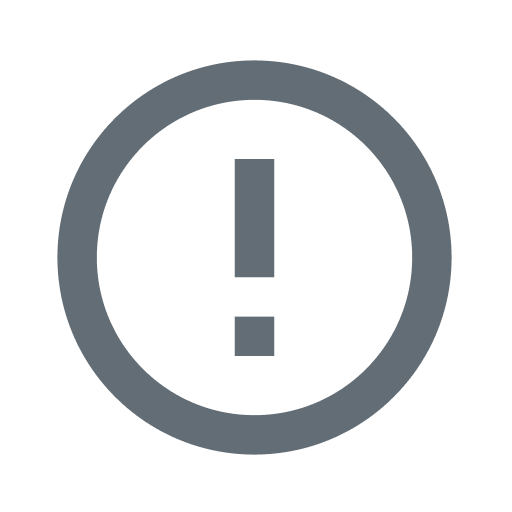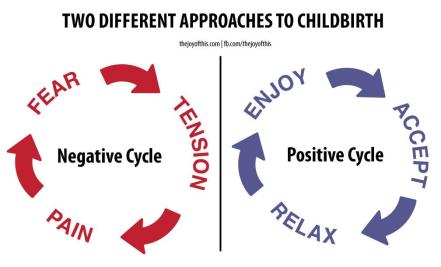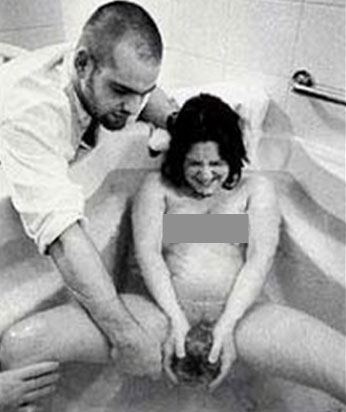Let’s talk about the perineum! (Yeah, high-five if you’ve got one – okay, it’s no secret everyone has one.) It’s a big concern among expectant moms, will my perineum make it out alive?
Sometimes in my childbirth classes I can literally see a huge floating question mark sitting on the tops of women’s heads. Like a thought bubble pleading silently, “Can you talk about vaginas, now!? Will mine ever look the same!? Will I be normal after birth? What will happen to my perineum during childbirth?”
Well, before we answer those questions we need to understand some of the sensations women may experience during childbirth and what we can do to protect the perineum through it all.
Alright, let’s dive right in, shall we? First let’s examine the vagina, or rather the vulva, and talk about the perineum and what happens towards the end of labor:
 The perineum is the skin between the vagina and the anus, which thins out and stretches over the baby’s presenting part (usually the head) as it is born. (Source) During second stage (pushing) the perineum plays an especially vital role in the birth of the baby.
The perineum is the skin between the vagina and the anus, which thins out and stretches over the baby’s presenting part (usually the head) as it is born. (Source) During second stage (pushing) the perineum plays an especially vital role in the birth of the baby.
Okay, let’s talk about what’s going on down there as we approach second stage!
(“Down there” and “bottom” are lite and easy words that I use to describe the vagina, vaginal opening, vulva, perineum and rectum. These are the words my midwife used with me and I will use them with you! Okidoki?)
Building Pressure:
As baby descends and engages and labor deeply progresses, a woman will experience increasing pressure in her bottom as her pelvic passage begins to stretch open. Often, the stimulation sends a signal to a laboring mother’s brain that she needs to have a bowel movement. And sometimes that’s exactly what a laboring mother may do.
I’ve worked with a lot of moms who, while in the thick of labor, look up at me with urgency and quickly move to the bathroom. Baby’s decent stimulated her bowels. On occasion the laboring mother may have a genuine need to go (this is nature’s lovely way of making sure that doesn’t happen during second stage), or other times the mom may simply relax on the toilet, letting her muscles soften till she becomes more comfortable with these new sensations. Either response is totally normal.
Keep in mind, the pressure felt during birth is sometimes really alarming, because, let’s be honest here, we’ve spent our whole life learning to be discrete about the urge to poop. But in the case of childbirth (and possibly a few other occasions!) this sensation is cause for celebration, it tells us baby is descending and the mother is moving closer towards holding her baby in her arms.
Grunting:
Often at this stage in labor, you’ll begin to hear mothers grunt at the peak of their contractions. Imagine, mom is moaning through her contraction and suddenly her breathy bellowing goes like this, “ooooooooooooooh, oooooooooooooooooh, ooooo uh, uh, uh, uh, uhr, uhr, uhr, oooooooooh, oooooooh, oooooh”
Aha! That’s a great sound! Those short little grunty noises that mom just made in the middle of her contraction signal that her body is beginning to involuntarily push at the peak of her rush.
Supportive Hands:
You’ll also sometimes see, as a laboring mother begins to feel that all-consuming pressure, that she will place her hands right on her bottom, cupping her groin and supporting her vulva. That’s wonderful and absolutely normal! Besides for giving her bottom additional support during this stage, it also allows the laboring mother to stay more in touch and in control of her body’s response to labor. What’s not to love!?
Pressure, grunting, and supportive hands are clear signs that birth is progressing…
Does that mean it’s time to push yet? No, not necessarily. It only means what she’s telling us from her body language: her bottom is feeling pressure, things are being stimulated, baby is descending and birth is progressing normally.
Enjoy, Accept, Relax
At this transitional stage between first and second stage of labor, it’s ideal for mom to not add additional force (just yet!) as she begins to feel those early urges to push. As her uterus contracts, the bands of muscle thicken at the top of the fundus and begin to push down on their own, expelling baby further into the birth canal, this is the beginning of what will soon become a very strong urge to push.
It’s a good idea at this cross-road in labor to encourage mom to enjoy knowing just how well her body is working, accept the intensity of the change in sensations she’s feeling, and relax into her rushes a little more fully. This provides mom with an opportunity to wrap her brain around the idea of what the pushing urge feels like before diving right into it.
Powerful Pressure | Second Stage | Pushing
As labor thickens into heavy travail (an old Biblical word that I feel really adequately describes transitional labor) the intensity of pressure a woman begins to feel increases exponentially.
Baby’s head is now stretching the vaginal and pelvic floor muscles. Receptors in these tissues trigger involuntary pushing, and signal more oxytocin to the body – a complex hormone which stimulates contractions. (Source) A woman will now begin to feel the urge to push through almost the entirety of her contraction and not just the peak of it.
Mom will need reassurance at this point that she is okay, she needs to know that the pressure she feels is normal, and that even if she’s absolutely convinced she will birth her baby out of her butt, she will not. (Yeah, I said it.)
The intensity of the pressure is admittedly scary, but it’s also needed in order to bring forth baby into the world. And while it’s like nothing any first-time mother will have felt before, and can be utterly overwhelming, it is still very normal in terms of childbirth and not to be feared.
This is a doorway in labor that mothers walk through, there is no way around this passage of birth intensity, only through it. It is time to push!

Please note, while these illustrations are fantastic, the information on step four regarding suctioning a baby is now contraindicated and outdated. Evidence now states that unless baby is unresponsive, suctioning is not necessary. Source: //www.ncbi.nlm.nih.gov/pmc/articles/PMC2666857/
Two Steps Forward, One Step Back
As mom pushes her baby down and out in that wonderful “J” shape of pushing, we’ll often see a little two-step dance, baby descends during the contraction, pressing on the perineum and the perineum begins to bulge and expand, and after the contraction ends, baby moves up and the perineum softens and relaxes. This happens over and over again.
This is a process my own midwives and mentors taught me to refer to as “two steps forward, one step back.” This dance is very important for the integrity of the perineum. It allows the skin to stretch slowly and gently, giving the perineum time to accommodate the baby’s head without tearing.
Ring of Fire
Once the head of the baby has firmly ducked under the pelvic bone, crowning will begin to take place. We use the term “crowning” to describe how the vaginal opening and vulva stretches around baby’s head looking like a crown.
As baby crowns, the labia and perineum begin to expand and bulge, this point is often referred to as the “ring of fire.” There is a lot of stinging and burning accompanied with the ring of fire, fortunately, it doesn’t last for too long, although we shouldn’t rush through it. This stinging sensation sends a message to the woman’s body to hold off on pushing. (Source)
(On a side note, sometimes as an exercise to describe the ring of fire to my students, I’ll ask them to stretch open the sides of their mouth with their fingers. I find this gives a good sense of the type of stinging that’s felt in birth. As a bonus, everyone looking ridiculous together usually gets us all laughing, which is always good when talking about crowning!)
During crowning it’s good for the laboring mother to stop adding additional force to her body’s own urge to push. Instead she should breathe out her baby and allow her body to do the work on its own. (This is something she has already practiced in birth during the transitional stage mentioned above. See, it all comes together now!)
You see, after the baby’s head is through the pelvis, only the tender perineal tissues are holding baby in (Source), and the mother needs to be mindful of not pushing too forcefully in order to protect this area of a her body.
How does she do that? She breathes her baby out…
Breathing Baby Out
Gentle, easy breaths that resemble panting allow the baby’s head to emerge slowly and tenderly, helping to keep the perineum intact. Actually, for many mothers breathing out her baby is an innate response to the ring of fire.
Think about it: a base response to pain, for all ages, are quick short breaths. I see my children do this all the time. A little high-pitched panting expression that happens when they’ve smashed their finger or stubbed their little toe.
Likewise, when mothers are left to labor without heavy coaching, at the point of crowning, you’ll sometimes see this panting and high-pitched breathing technique occur. (Watch some birth videos, and listen for that quick high-pitched breathy howl at crowning, and then you’ll start to see it all the time.)
Supporting The Perineum
Also, a mother’s hands may instinctively reach down again and apply pressure to her own perineum. Although, I should mention it’s quite common that you’ll see the midwife or OB apply slight counter pressure to a woman’s perineum at this stage too. Also, some care providers will apply a warm compress or olive oil to a mother’s perineum to assist in preventing tears.
To view a photograph of a crowning baby and a perineum stretching out beautifully in birth click this link from wisewomanchildbirth: Perineum stretching in birth.
Once the baby’s head has fully crowned, it will only be another couple of pushes before baby is born. After the birth of the baby’s head, baby’s shoulders are delivered, and the rest of the baby’s body pours out from its mother shortly after.
It’s miraculous to see and testifies to the function and beauty of the female body.Women’s bodies are just amazing, y’all!
There are a lot of things a woman can do that will increase her chances of having an intact perineum, here are a few of my tips, please note this list is not exhaustive or comprehensive:
- Diet and hydration play a valuable role in the health of a woman’s perineum, for a great post on this go here: Protecting Your Perineum From The Inside Out
- Practice pelvic floor exercises during pregnancy. (You may want to rethink Kegels, here’s a link that says why: Pelvic Floor Party, Kegels Are Not Invited)
- A mother should avoid birthing on her back, but rather birth on her side, in an upright position, or on her hands and knees.
- Warm compresses (not hot!) on the perineum during labor.
- Avoid power pushing. Power pushing, or what is known as purple pushing, is when a woman holds her breath for long periods of time and pushes beyond what feels comfortable or natural to her body. This type of pushing increases a woman’s chance of tearing.
- Avoid widely flexed legs. Knees should be pointing forward and not to the sides. Source | Source
- Follow her own body’s cues during crowning and slow down her pushing.
- Use a mirror, if she’s comfortable with that. Seeing what’s happening during second stage can help the mother connect to her body, and allow her to direct her body’s urges better.
- The laboring mother should move to positions that are most comfortable for her during second stage. For example, the mother could say, “Before my next contraction starts, I would like to turn to my left side. Would you help me do this, please?”
- Hire a doula! A doula reduces a woman’s need for an epidural and for forceps delivery, both of which increase the laboring mother’s odds of perineal damage.
- The mother should find a care provider who supports birthing in ways which allow for an intact perineum.
Related articles
What You Don’t Know About Episiotomies Can Hurt You (parenting.blogs.nytimes.com)
Get Through Childbirth in One Piece!
Avoiding Tears and Episiotomies
Perineal Protectors (read the comments, too!)
Some content on this page was disabled on June 25, 2023 as a result of a DMCA takedown notice from Nucleus Medical Media, Inc. You can learn more about the DMCA here:









